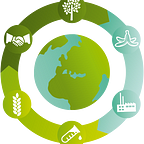Does “circular” mean “sustainable”? The case of urban farming
Author: Martí Rufí-Salís
Quantification is key to make grounded decisions. Stating that a chair, a house or even a country is performing better than another is not possible without quantifying a certain parameter, call it size, productivity or durability. Quantifying the sustainability of a system is no exception, but it is easier said than done. It is quite tricky to analyze complex production systems such as food supply chains with multiple sources of data. It gets even trickier when scientists do not agree on the methods and tools we should use to quantify sustainability. And it gets even trickier when assessing emerging sustainability frameworks like the circular economy, for which we still lack a precise definition. The question is: what exactly should we quantify, how and why?
My doctoral thesis on circular urban farming has tried to answer this question in collaboration with the Circulus research group, but let me first tell you the story of how I came to it. In my thesis, I used methods such as life cycle assessment to estimate to what extent applying circular solutions to urban agriculture is good for the environment. For example, I studied the recovery of nutrients lost during plant growth such as nitrogen or phosphorus, which are scarce in nature and can be reused in crops. Then I calculated the environmental impacts and benefits from these solutions, such as the carbon footprint or resource depletion. My analysis was far from conventional, as the scenery for my experiments was an integrated rooftop greenhouse in Barcelona.
But as I was happily playing around with some tomato crops in my little paradise, I realized that we can measure many different things, which at the same time leads us to different conclusions. If what we measure is how circular we are, we will apply all kinds of strategies to achieve this goal. In the case of crops, we will harvest rainwater, recover nutrients, use recycled materials, redesign our infrastructure… Is this equivalent to becoming more environmentally friendly? I realized that this is like comparing apples with oranges, so I decided to do some research and studied what we should quantify to make sure that circular strategies are good for the environment.
My aim was very concrete. I wanted to check how the application of a variety of circular strategies affects the environmental impacts of my tomato crops, but first I had to answer another question: how can we say that a circular strategy is indeed circular? Quantification is key. Stating that a chair, a house… wait, I already said that. To quantify how circular a strategy is, I used the Material Circularity Indicator by the Ellen MacArthur Foundation. In the process, I found relevant limitations from this indicator when applied to my system. As it only measures mass flows, the circularity of the rooftop farm depended on the amount of water used, which is the largest flow in agricultural systems. In contrast, energy and transportation were not included. In summary, I could not tell which strategies where more circular, as each of them targets different flows — not only water.
I studied what we should quantify to make sure that circular strategies are good for the environment
To get over my frustration, I did what I know best, which is to quantify environmental impacts. At this point, applying life cycle assessment doesn’t sound like something really novel, but I observed that specific strategies improve the environmental performance of the system. For instance, water and nutrient recirculation almost eliminated the effects of the urban rooftop farm on eutrophication. At the same time, other environmental impacts increased, such as global warming or cumulative energy demand due to the amount of new infrastructure required. Well, how could we expect to reach urban sustainability so easily, right?
So what was my conclusion? We can’t just focus on measuring circularity if we want to reach sustainability. To align these two concepts, I developed a set of indicators that will help us compare circular strategies, set environmental targets and prioritize the strategies that work best for the environment. To find out more, check out our paper below and feel free to contact me!
